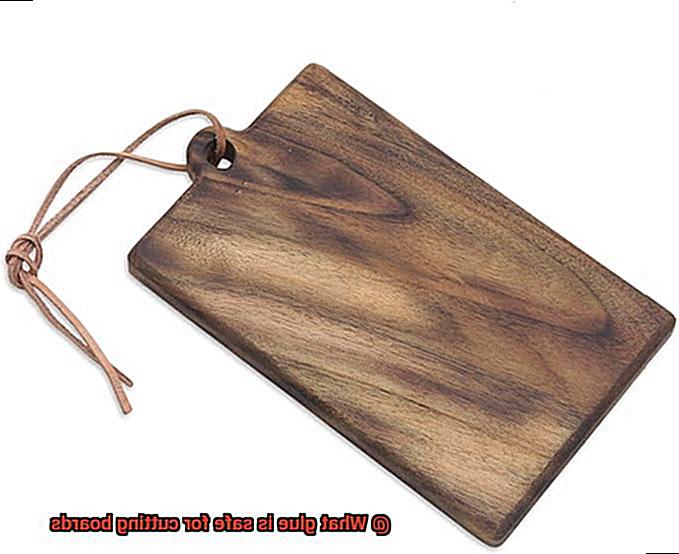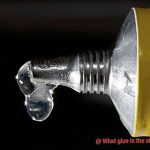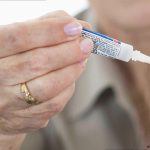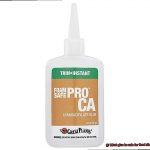Are you a kitchen wizard who loves whipping up mouthwatering meals? Or maybe you’re a crafty soul who enjoys creating your own cutting boards.
Either way, I bet you’ve wondered about the best glue to use for assembling those beautiful boards. Well, my friend, today is your lucky day.
In this blog post, we’re diving headfirst into the world of safe glues for cutting boards. We’ll uncover the secrets of water-resistant PVA glues and FDA-approved epoxy adhesives, so you can confidently put together a durable and food-safe masterpiece.
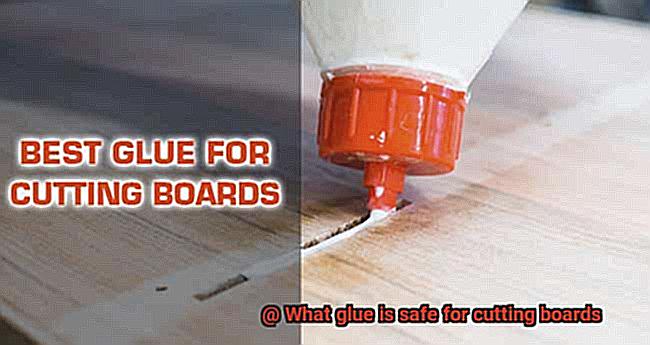
So grab that glue and let’s get sticking.
What Glue Should Be Used for Cutting Boards?
Contents
Choosing the right glue for cutting boards is not just about creating a strong bond, but also ensuring food safety. In this comprehensive guide, we will delve into the top glues for cutting boards and explore why they are the best options available.
FDA-Approved Food-Grade Epoxy:
One of the most recommended glues for cutting boards is FDA-approved food-grade epoxy. This adhesive is renowned for its exceptional bonding strength, making it perfect for joining wood pieces. Not only does it withstand water, heat, and chemicals, but it also creates a waterproof seal that protects the wood from moisture damage.
Polyurethane Glue:
Polyurethane glue is another popular choice for cutting board assembly. Similar to epoxy, polyurethane glue is food-safe and forms a strong bond. What sets it apart is its unique ability to expand as it cures, filling any gaps or imperfections in the wood joints. However, bear in mind that polyurethane glue requires moisture to activate the curing process, which can be a challenge during application.
Wood Glue:
Wood glue, such as Titebond III, is a safe and user-friendly option for cutting boards. Non-toxic and easy to work with, wood glue provides a strong bond between wood pieces. Nevertheless, it may not be as resistant to water and heat as epoxy or polyurethane glue. Therefore, extra care should be taken to avoid prolonged exposure to moisture.
Avoid Regular Household Glues:
It is crucial to steer clear of regular household glues like super glue or construction adhesive when working with cutting boards. These glues are not designed for food contact and may contain harmful chemicals that can leach into the food being prepared on the board. To ensure food safety, always opt for glues specifically formulated for food-related applications.
Additional Considerations:
In addition to choosing the right glue, there are other factors to consider when working with cutting boards. Applying food-safe finishes like mineral oil or beeswax helps protect the wood and facilitates easy cleaning. Regular maintenance, including sanding and reapplying finishes, can also extend the lifespan of a cutting board.
FDA-Approved Food-Safe Epoxy
When it comes to sealing and protecting your cutting boards, using FDA-approved food-safe epoxy is an absolute must. Not only does it provide a strong and durable bond, but it also ensures the safety of your food. Here’s why:
- FDA Approval: The Food and Drug Administration (FDA) is responsible for regulating products that come into contact with food. By using FDA-approved epoxy, you can rest assured that it meets the strict safety standards set by this regulatory agency.
- Non-Toxic Formulation: Food-safe epoxy resins are specifically formulated to be free from harmful chemicals and additives. This means that there is no risk of these substances leaching into your food and causing health problems.
- Moisture and Heat Resistance: Cutting boards are exposed to moisture and heat on a regular basis. Food-safe epoxy resins are designed to be resistant to these elements, ensuring that they won’t degrade or break down over time.
- Bacteria Growth Prevention: The smooth, non-porous surface created by food-safe epoxy resins makes it difficult for bacteria to thrive. This helps keep your cutting board clean and hygienic, reducing the risk of foodborne illnesses.
- UV Resistance: Some food-safe epoxy resins offer UV resistance, which means that they won’t yellow or discolor when exposed to sunlight. This helps maintain the aesthetic appeal of your cutting board.
In summary, FDA-approved food-safe epoxy provides numerous benefits for sealing and protecting cutting boards:
- FDA approval guarantees that the epoxy meets strict safety standards.
- Non-toxic formulation ensures no harmful substances leach into your food.
- Moisture and heat resistance prevents degradation over time.
- Bacteria growth prevention keeps your cutting board clean and hygienic.
- UV resistance maintains the aesthetic appeal of your cutting board.
Food-Grade Wood Glue
Whether you are a professional chef or a passionate home cook, having a reliable and safe cutting board is essential for preparing delicious meals. But have you ever considered the glue that holds your cutting board together? Enter food-grade wood glue – the unsung hero of cutting board construction.
Food-grade wood glue is a specially formulated adhesive that is designed to be safe for use on cutting boards and other kitchen utensils that come into contact with food. Unlike regular wood glue, which may contain toxic chemicals that can potentially leach into your food, food-grade wood glue is non-toxic and free from harmful substances. This means you can chop, slice, and dice without worrying about any unwanted additives sneaking their way into your meals.
One of the primary concerns with using regular wood glue on cutting boards is the potential for toxic chemicals to contaminate the food. Food-grade wood glue eliminates this risk by being specifically designed to meet the standards set by regulatory bodies such as the FDA (Food and Drug Administration) and NSF (National Sanitation Foundation). These glues undergo rigorous testing to ensure they are non-toxic, resistant to water and heat, and durable enough to withstand the demands of a busy kitchen.
The ingredients used in food-grade wood glue are carefully selected to ensure they are safe for use in food preparation areas. Typically, these glues are made from natural resins, water, and additives that enhance the adhesive properties of the glue. This combination creates a strong and long-lasting bond between the wooden components of your cutting board.
When using food-grade wood glue on your cutting board, it is important to follow the manufacturer’s instructions for application and curing time. This will ensure that the glue forms a strong bond while remaining safe for food contact. Additionally, food-grade wood glue is not limited to cutting boards alone. You can also use it for other kitchen projects such as repairing wooden utensils or assembling wooden furniture.
When shopping for food-grade wood glue, look for products that are specifically labeled as such. This will give you peace of mind knowing that you are using a glue that has been tested and approved for use in food-related applications. However, it is worth noting that while food-grade wood glue is safe for incidental food contact, it is not meant to be ingested directly. Therefore, it is important to handle and store the glue properly, keeping it out of reach of children and pets.
Natural Adhesives for Cutting Boards
These adhesives, derived from natural materials, offer a safer and more eco-friendly option compared to synthetic adhesives.
One of the most commonly used natural adhesives for cutting boards is food-grade wood glue. This adhesive is specially formulated to be safe for use on surfaces that come into contact with food. Made from natural ingredients like vegetable proteins, food-grade wood glue is non-toxic and eco-friendly. It provides a strong bond, ensuring that no harmful chemicals will leach into your delicious meals.
Hide glue is another ancient natural adhesive that has been used in woodworking for centuries. Made from animal collagen, typically sourced from cows or horses, hide glue is non-toxic and can withstand high temperatures. This makes it an excellent choice if you plan on using your cutting board as a hot plate or exposing it to heat.
If you’re looking for an adhesive that can also help seal cracks and gaps in the wood, beeswax is the perfect option. This natural wax, produced by bees, has excellent adhesive properties and can prevent moisture or food particles from getting trapped in your cutting board. Additionally, beeswax adds a lovely shine to the wood, giving your board a polished and professional look.
For those who prefer oils over traditional adhesives, mineral oil or walnut oil can be used to moisturize and protect your cutting board. These natural oils penetrate the wood fibers, keeping it hydrated and preventing it from drying out or cracking. However, it’s important to note that oils alone may not provide a strong bond and may need to be combined with other adhesives.
When choosing a natural adhesive for your cutting board, always ensure it is food-safe and free from toxic substances. Look for certifications or labels indicating that the adhesive is specifically designed for use on cutting boards or food contact surfaces.
Proper care and maintenance of your cutting board are essential regardless of the adhesive used. Regular cleaning, drying, and oiling will help keep your cutting board in top shape and prevent any bacterial growth.
Regular Household Glues to Avoid
When it comes to choosing the right glue for your cutting board, regular household glues should be avoided. While they may seem convenient, these glues can contain harmful chemicals that can contaminate your food or release toxic fumes when exposed to heat or moisture. To ensure the safety of your cutting board, it’s best to opt for adhesives that are specifically formulated for food contact and labeled as food-safe.
Here are some types of regular household glues that should be avoided for cutting boards:
- Super Glue (Cyanoacrylate): Super glue is known for its fast-drying properties and strong bond. However, it is not food-safe. When subjected to high temperatures or moisture, super glue can release toxic fumes that are harmful to your health. So, save the super glue for other projects and keep it away from your cutting boards.
- Epoxy: Epoxy is a popular adhesive for its strength and durability. However, most epoxy formulations contain chemicals that are not food-safe. These chemicals can contaminate your food when in direct contact with the adhesive. So, while epoxy may be great for other applications, it’s best to avoid it when it comes to bonding your cutting board.
- Construction Adhesive: Construction adhesive is designed for non-food contact surfaces and should be avoided for cutting boards. Over time, these adhesives can release harmful chemicals that can seep into your food. So, even though construction adhesive may be strong and heavy-duty, it’s not suitable for your cutting board.
- Hot Glue: Hot glue guns are a staple in every crafter’s toolbox but should not be used to bond cutting board materials. Hot glue can soften or melt when exposed to high temperatures, such as when hot pots or pans are placed on the cutting board. This can cause the glue to become unstuck and potentially contaminate your food.
- Wood Glue: While wood glue is specifically designed for woodworking projects, not all wood glues are safe for cutting boards. Some wood glues contain chemicals that may not be food-safe, making them unsuitable for direct contact with food.
To ensure the safety of your cutting board, it’s best to use adhesives that are specifically formulated for food contact and labeled as food-safe. These specialty glues are non-toxic and resistant to heat and moisture, making them the perfect choice for bonding your cutting board materials securely.
Applying the Chosen Adhesive
Maintaining the integrity of your cutting board requires the use of the right adhesive. In this comprehensive guide, we will explore the step-by-step process for properly applying food-safe adhesive to your cutting board. Whether you choose food-safe epoxy, wood glue, or a natural alternative, we have expert tips and advice to ensure a strong bond that is both safe for food contact and built to last.
Step 1: Preparing the Surface
Before diving into the adhesive application process, it is crucial to prepare the cutting board’s surface. Begin by sanding down the wood, removing any dirt or debris that may hinder proper adhesion. This step lays the foundation, providing a clean canvas for the adhesive to work its magic.
Step 2: Food-Safe Epoxy Application
Food-safe epoxy is a popular choice due to its strength, durability, and moisture resistance. Start by mixing equal parts of the resin and hardener according to the manufacturer’s instructions. Using a disposable brush or applicator, evenly spread the epoxy over the wood surface, ensuring complete coverage of all areas including edges and corners.
Step 3: Clamping and Curing
With the epoxy applied, firmly clamp the wood pieces together to create a secure bond. Allow the adhesive to cure according to the manufacturer’s recommended drying time, usually between 24 to 48 hours. Patience during this stage will reward you with a cutting board that can withstand regular use and washing without losing its grip.
Step 4: Exploring Food-Safe Wood Glue
For those who prefer an alternative to epoxy, food-safe wood glue is an excellent choice. This specialized adhesive is formulated specifically for bonding wood surfaces and is non-toxic when dry. Begin by ensuring clean surfaces free from dust or residue. Apply a thin layer of wood glue to one surface and press the pieces together firmly. To ensure a secure bond, use clamps or heavy objects to hold the pieces in place while the glue dries.
In addition to epoxy and wood glue, natural alternatives can also be used as adhesives for cutting boards. Food-grade mineral oil, for example, creates a protective barrier on the wood surface, preventing moisture absorption. While not as strong as epoxy or wood glue, this option offers a safe and natural solution for those seeking alternative methods.
Step 6: Drying Time is Key
Regardless of the adhesive chosen, allowing sufficient drying or curing time is crucial. This ensures that the adhesive has fully bonded and is safe for food contact. Remember, patience is indeed a virtue when securing your cutting board for long-term use.
Maintaining Proper Hygiene and Cleanliness
When it comes to the kitchen, proper hygiene and cleanliness are of utmost importance, especially when it involves the cutting board. This humble kitchen tool may seem insignificant, but if not properly maintained, it can become a breeding ground for harmful bacteria and other contaminants. In this comprehensive guide, we will take you through a step-by-step process to ensure the hygiene and cleanliness of your cutting board, creating a safe and healthy cooking environment.
Step 1: Wash Thoroughly
After each use, it is crucial to wash your cutting board with hot soapy water. Use a scrub brush or sponge to eliminate any food particles or stains that may have clung to it. Hot water acts as a powerful weapon against bacteria, while a mild dish soap ensures a thorough clean without damaging the board.
Step 2: Rinse Well
Once you have scrubbed away all traces of food and soap, rinse your cutting board thoroughly with clean water. This step is vital to remove any residue that could affect the taste of your food or contaminate it.
Step 3: Dry Properly
Moisture is the enemy when it comes to maintaining a clean cutting board. Ensure that the board is completely dry before storing it away. You can either air dry it on a clean surface or use a clean towel to speed up the process.
Step 4: Sanitize Periodically
Regular sanitization is essential to kill any remaining bacteria or pathogens on the surface of your cutting board. You have various options for sanitizing agents such as bleach and water (following proper dilution ratios), hydrogen peroxide, or white vinegar. Just remember to carefully follow instructions to avoid damaging the board.
Step 5: Prevent Cross-Contamination
To prevent cross-contamination, it’s advisable to have separate cutting boards for different types of foods. Use one specifically for raw meats, another for fruits and vegetables, and a third for cooked foods. This simple step ensures that harmful bacteria from raw meats don’t transfer to other foods.
Step 6: Inspect Regularly
Make it a habit to regularly inspect your cutting board for signs of wear or damage. Deep cuts or grooves in the surface can harbor bacteria and are difficult to clean thoroughly. If you notice any damage, it’s best to replace the cutting board to maintain proper hygiene and food safety.
Maintaining proper hygiene and cleanliness is crucial when it comes to your cutting board. By following these simple steps – washing thoroughly, rinsing well, drying properly, sanitizing periodically, preventing cross-contamination, and inspecting regularly – you can ensure a safe and healthy cooking environment. So, keep your cutting board clean and enjoy worry-free meal preparation.
yChMFzqVVLc” >
Conclusion
In conclusion, selecting the appropriate glue for cutting boards is crucial to guarantee a secure bond and maintain food safety. When assembling cutting boards, there are several safe options to consider: FDA-approved food-grade epoxy, polyurethane glue, and wood glue.
FDA-approved food-grade epoxy stands out as an exceptional choice due to its remarkable bonding strength, water resistance, and ability to create a protective waterproof seal that shields the wood from moisture damage. Not only is it non-toxic and heat resistant, but it also inhibits bacteria growth.
Polyurethane glue is another favored option because of its unique property of expanding as it cures. This characteristic allows it to fill gaps or imperfections in wood joints effectively. However, keep in mind that this type of glue requires moisture during application for activation.
While wood glue like Titebond III is safe and user-friendly, it may not possess the same level of water and heat resistance as epoxy or polyurethane glue. Therefore, extra caution should be exercised to avoid prolonged exposure to moisture.
It’s important to steer clear of regular household glues such as super glue or construction adhesive. These adhesives are not intended for food contact and may contain harmful chemicals that can seep into the food prepared on the cutting board.
For those seeking more natural alternatives, food-grade wood glue made from vegetable proteins or hide glue derived from animal collagen offer safer and eco-friendly options compared to synthetic adhesives.
Proper care and maintenance play a vital role in extending the lifespan of cutting boards while ensuring hygiene. Applying food-safe finishes like mineral oil or beeswax, regular cleaning routines, thorough drying processes, and periodic oiling will help preserve your cutting board’s integrity.
To summarize, when selecting an adhesive for your cutting board assembly needs, prioritize glues specifically formulated for food-related applications. Look for qualities such as non-toxicity, heat resistance, water resistance, durability, and bacteria prevention.

